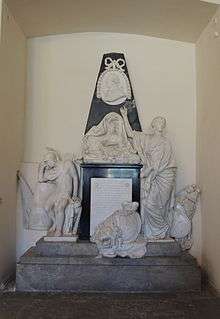Fyodor Gordeyev
Fyodor Gordeyevich Gordeyev (Russian: Фёдор Гордеевич Гордеев; 1744 - 4 February 1810) was a Russian sculptor.
Life

Born in Saint Petersburg, he attended the Imperial Academy of Fine Arts in the city[1][2] and then went on a study trip to Western Europe thanks to the bursary.[3][2] This took him to Paris, where he studied in the studio of Jean-Baptiste Lemoyne[1], then Rome, where he was influenced by classical art.[3]
After returning to Russia, he was commissioned to teach sculpture at the Academy in 1769[1] Around the same time he produced the noted bas-relief Mercury Entrusting Bacchus to the Nymphs (1776). In 1802 he was made rector of the Academy.[3] Art critics came to see Gordeyev as one of the best Russian neo-classical sculptors,[2] although his early work such as Tomb of N. M. Golicyn (1780) still included influences from the Baroque[2][3]. His final works also showed traces of Baroque influence.[3]
His most important works include Prometheus (1769), Monument to A. M. Golitsyn in Alexander Nevsky Lavra in Saint Petersburg (1788), the bas-reliefs of the Ostankino Palace in Moscow (1798), and the bas-reliefs on the tympanum of the Kazan Cathedral in Saint Petersburg (1804).[3][1][2] He also produced portraits and history paintings.[1] He died in St Petersburg.
References
- "'Fyodor Gordeyev' in Treccani.it – Enciclopedie on line, Istituto dell'Enciclopedia Italiana, 15 March 2011".
- "Gordeev, Fëdor Gordeevič". Retrieved 16 August 2018.
- le muse, V, Novara, De Agostini, 1964, p. 330.